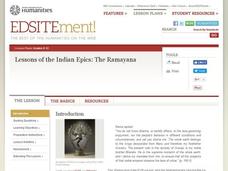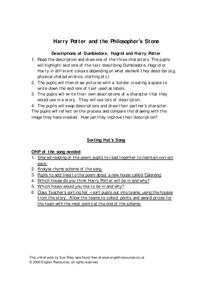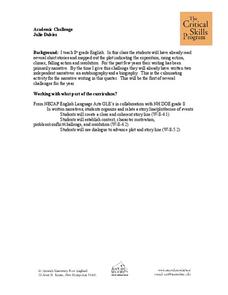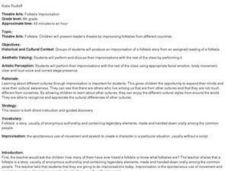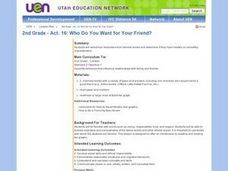Curated OER
Outline and Shine
Seventh graders read and discuss a short story. They complete an outline of the story. They pair and share to evaluate each other's outlines.
Curated OER
Comprehension
Fifth graders take part in a panel discussion. In this character lesson students show their understanding of the connection between events in a story and the development of characters. Students provide evidence from the story to support...
Curated OER
Create An Ending
Students create a new ending for a familiar story that stand alone with a clear beginning, middle and end. As a class, students review a familiar text focusing on plot and character development. In small groups, students work...
Curated OER
Using Graphic Organizers to Generate Genre Definitions
Students listen to or read a variety of stories and then work individually or in groups to complete graphic organizers that will help them focus on elements within different types of stories. They write definitions for a variety of story...
Curated OER
Lessons of the Indian Epics: The Ramayana
Students read a version of Ramayana and explore the elements of the epic hero cycle. In this Ramayana analysis lesson, students retell the basic narrative of the Ramayana and identify the main characters. Students identify elements of...
Curated OER
Main Events in Fiction
Young scholars complete a literature analysis of fiction texts to study elements of fiction. In this fiction analysis activity, students read various fiction texts and examine them to learn about fiction elements. Young scholars learn to...
Curated OER
Writing a Children's Book -- Young Authors
Pupils practice their writing skills by creating a children's book. They integrate five elements of short stories into the narrative. They share their stories with their book buddies.
Curated OER
Writing Application: The Canterbury Tales
Students read stories from The Canterbury Tales by Geoffrey Chaucer and create their own tale. In this writing applications lesson, students read the tales and analyze the specific details that Chaucer use. Students work in groups to...
Curated OER
Where in the World is Cinderella?
Students read several versions of the Cinderella story and examine variations from different cultures. They consider how point of view affects a story and develop a multimedia presentation with their observations.
Curated OER
Harry Potter and the Philosopher's Stone
For this Harry Potter and the Philosopher's Stone worksheet, students draw characters from the book, write descriptions about the character, and then exchange another students description and draw the character they described. Students...
Curated OER
Storytelling
Students compose a story and tell it to the class. In this storytelling lesson, students work in small groups to create an illustrated story. Students are given a checklist of elements to include in the assignment. Students then create...
Curated OER
Fable Writing--Inter-disciplinary Approach To Social Sciences
Students recognize the elements of a fable and write an original fable. They make connections with morals and other law-related concepts.
Curated OER
Gingerbread Baby Language Arts/Grammer #6
Learners are read the story "Gingerbread Baby". They draw and cut out the characters from the story and create a mobile to hang from their classroom ceiling. They write a sentence using a verb on the back.
Curated OER
Gingerbread Baby Board Game #10
Learners are read the book "Gingerbread Baby". They examine the journey the baby traveled in the story and in turn create a game board. They draw pictures along the board to show different parts of the story.
Curated OER
Shadow Puppetry in South India
Students read a variety of literature from India, including folktales and fables. They then select a scene or story to script, work together to design and craft shadow puppets of characters and scenery, narrate a story, manipulate the...
Curated OER
Gingerbread Baby v. Gingerbread Boy #7
Students compare and contrast the gingerbread baby in their story to the original gingerbread boy. They use a Venn diagram to easily see the similarities and differences.
Curated OER
Persuasion
Students read various stories and write reflections in their journals. Using the text, they identify the techniques the characters used in persuading the reader or other characters in the story.They rewrite a fairy tale from the villains...
Curated OER
Folktale Improvisation
Sixth graders present reader's theatre by improvising folktales from different countries. In groups, they produce an improvisation of a folktale story from an assigned reading of a folktale.
Curated OER
Fractured Fairy Tales
Students use familiar characters, plots, and settings from traditional fairy tales to create "fractured" versions, while experimenting with satire, irony and parody. A fractured fairy tale is designed to be humorous by changing the story...
Curated OER
Who Do You Want For Your Friend?
Second graders create a t-chart about the healthy and unhealthy characteristics in relationships. They discuss elements they should look for in a friend. They are read books to identify these elements.
Curated OER
Mary Shelley's Frankenstein
Students complete close reading and analysis activities for Mary Shelley's Frankenstein. In this literature analysis lesson, students complete multiple close reading and analysis activities to evaluate the 19th century story.
Curated OER
Prometheus Eulogy
Young scholars write a eulogy for the mythological character, Prometheus. In this Greek myth lesson, students read a story about Prometheus and view a PowerPoint. Young scholars discuss the elements of a eulogy and then write one for...
Curated OER
Puppet Frogs
Learners identify the elements of line, shape, and color and expressive qualities of pictorial representation. Students create their own puppet frog using emotion and perform in a reader's theater. Learners listen to various pieces of...
Curated OER
Because of Winn Dixie: Water Management Practices
Fourth graders read the book Because of Winn Dixie and define the characters, setting, and plot. In this Winn Dixie lesson plan, 4th graders also identify quality water management techniques addressed in the story.






